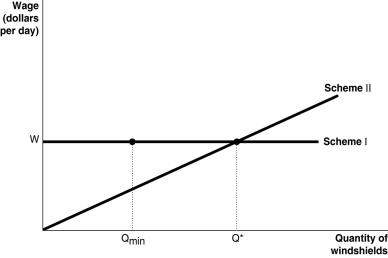
Figure 14.5

Figure 14.5 shows two different compensation schemes for the Safelite Glass Corporation, an installer of auto glass windshields. Under Scheme I, the firm pays a consistent wage of $160 per day based on an 8-hour workday. Qmᵢn represents the cut-off point under the hourly-wage system: if a worker installed fewer than Qmᵢn windshields, the worker got fired. Scheme II represents a piece-rate scheme with an earnings floor: no worker would get less than $160 per day (for an 8-hour workday) and would have to produce at least Qmᵢn. For any output level beyond Q* the worker earned an additional $20 for each unit produced.
-Refer to Figure 14.5.Under Scheme I,
A) workers compete with each other to see who can produce beyond Qmᵢn in the shortest possible time.
B) workers have no incentive to produce beyond Qmᵢn.
C) workers signal their productivity to the firm by consistently producing above Qmᵢn.
D) the incentive to increase productivity depends on where Qmᵢn is set; if it is at a very high level, then workers will rise to the challenge for fear of losing their jobs.
Correct Answer:
Verified
Q141: The town of Banff has a fixed
Q146: A monopsony is a firm which is
Q223: Which of the following statements about commission
Q234: A successful compensation scheme
A)must pay workers with
Q246: If a firm is the sole employer
Q248: Economic rent is defined as
A)what you pay
Q256: When workers are paid on a piece-rate
Q261: What is a monopsony?
Q266: The supply curve of a uniquely talented
Q268: The market price of a factor of
Unlock this Answer For Free Now!
View this answer and more for free by performing one of the following actions

Scan the QR code to install the App and get 2 free unlocks

Unlock quizzes for free by uploading documents